This is the website of Abulsme Noibatno Itramne (also known as Sam Minter).
Posts here are rare these days. For current stuff, follow me on Mastodon
|
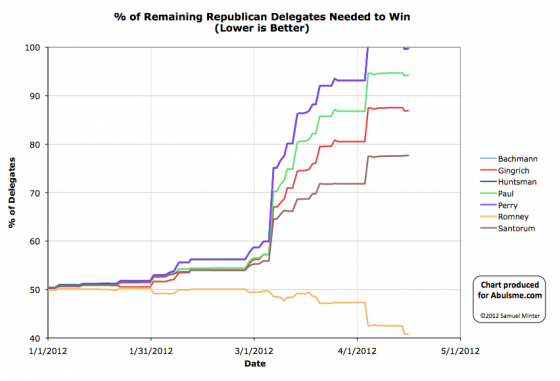
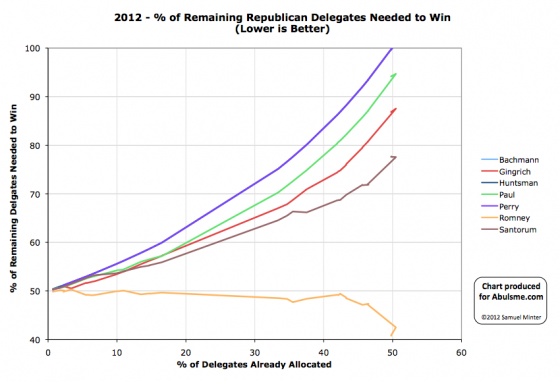
Charts from the Abulsme.com 2012 Republican Delegate Count Graphs page. When a candidate gets down to 0%, they have clinched the nomination. If they get above 100%, they have been mathematically eliminated. The first chart is by date, the second is by “% of Delegates Already Allocated”. These numbers include estimates of the eventual results of multi-stage caucus processes which will be refined as the later stages occur.
Very shortly after my update yesterday, Green Papers updated their Wyoming soft count numbers again. They had been Romney 22, Santorum 2, Paul 1, and 4 TBD. They are now Romney 23, Santorum 2, Paul 1, and 3 TBD. So one of the uncommitted delegates moved to the Romney column. So Romney +1 delegate for the day. Very minor change.
In terms of “% of remaining needed to win”:
- Romney: 40.85% -> 40.80%
- Santorum: 77.61% -> 77.68%
- Gingrich: 86.85% -> 86.92%
- Paul: 94.16% -> 94.25%
- Other: 99.65% -> 99.74%
I believe there are also two New York superdelegates that have come out for Romney that have been tracked by DCW that Green Papers hasn’t added to their totals yet. Since Green Papers now incorporates the DCW numbers, I don’t add them separately as I did in the early days. If I did I’d have to do a lot of extra tracking to avoid double counting, so I’ll wait for Green Papers to add them to their master soft count, which I expect will happen soon.
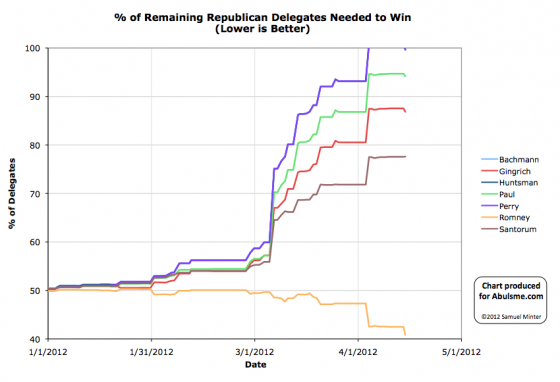
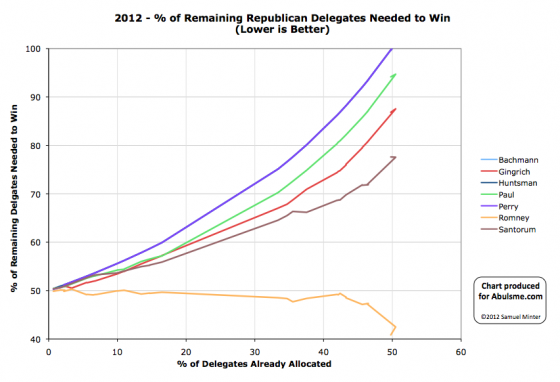
Charts from the Abulsme.com 2012 Republican Delegate Count Graphs page. When a candidate gets down to 0%, they have clinched the nomination. If they get above 100%, they have been mathematically eliminated. The first chart is by date, the second is by “% of Delegates Already Allocated”. These numbers include estimates of the eventual results of multi-stage caucus processes which will be refined as the later stages occur.
Wyoming and Colorado both have caucus type delegate allocation systems, where local caucuses earlier in the year are actually just the start of multi-month multi-stage processes. Both Colorado and Wyoming had their state conventions this weekend finishing off the delegate selection in those states.
Compared to the earlier estimates based on caucus results, the non-Romneys got crushed. Romney gained delegates. Everybody else lost delegates.
This is not surprising. It is common for the “clear winner” to end up taking far more delegates in the end than it looked like they would given the “straw poll” results at the first stage.
Looking more specifically…
- Colorado: The estimates after the caucuses were Santorum 13, Romney 12, Gingrich 4, Paul 4, and 3 uncommitted. This now becomes Romney 13, Santorum 6, and 17 uncommitted. All 36 delegates from Colorado are officially uncommitted, but using the current stated preferences of the delegates we have a net today from Colorado of Romney +1, Gingrich -4, Paul -4, Santorum -7.
- Wyoming: The estimates after the caucuses were Romney 11, Santorum 8, Paul 6, Gingrich 2, and 2 uncommitted. This now becomes Romney 22, Santorum 2, Paul 1, and 4 uncommitted. In Wyoming the delegates are bound. The net for the day in Wyoming is Romney +11, Gingrich -2, Paul -5, Santorum -6
Totaling the day we have Romney +12, Gingrich -6, Paul -9, Santorum -13. This does not look like a good day for the non-Romneys. Especially for Santorum. I guess dropping out of the race doesn’t help one’s ability to compete for delegates.
Notice though that we actually lost 16 delegates from the totals as some delegates that were predicted to go for specific candidates ended up uncommitted to any candidate. This actually increases the pool of potentially available delegates. In theory this improves the situation slightly for Gingrich and Paul, because, hey, they might still convince those uncommitted delegates to vote for them. (And indeed, some reports say many of those uncommitted delegates aren’t ready to support anybody else yet, but are not for Romney at this point either.) Santorum lost enough delegates that his situation actually gets worse anyway.
In terms of “% of remaining delegates needed to win”:
- Romney: 42.49% -> 40.85%
- Santorum: 77.56% -> 77.61%
- Gingrich: 87.54% -> 86.85%
- Paul: 94.70% -> 94.16%
I should also mention, that having these additional 16 delegates not committed brings the total number of delegates allocated by the estimates we use (the Green Papers soft count) back under 50% of the total number of delegates. Which actually means that the candidates with no delegates right now (Bachman, Huntsman, Perry, random others) are now no longer mathematically eliminated, and could catch up and win by capturing 99.65% of the remaining delegates. If they were actually on the ballot on all of the remaining states. Which they are not. :-)
So, uh, anyway… Romney still wins.
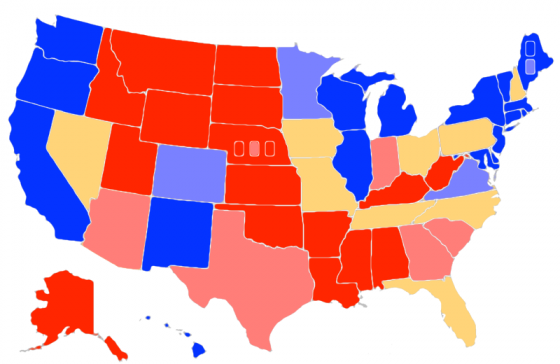
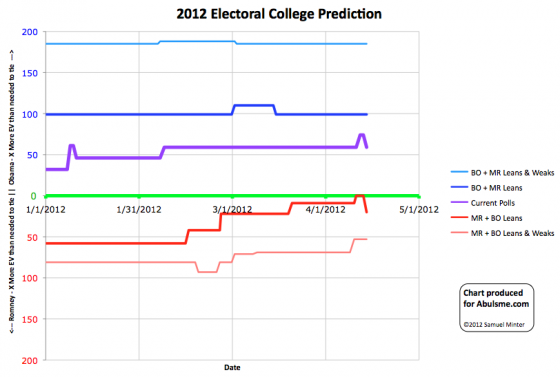
Map and chart from the Abulsme.com 2012 Electoral College Prediction page. Both assume Obama vs Romney with no third party strong enough to win states. Both show the polling situation as it currently exists. Things can and will change before election day. On the map Red is Romney, Blue is Obama, Gold States are too close to call. Lines on the chart represent how many more electoral votes a candidate would have than is needed to tie under several different scenarios. Up is good for Obama, Down is good for Romney.
As we have been saying for the last few updates, at some point the trend making things look better and better for Obama would come to an end. Today is that day. Two states change categories.
North Carolina: Only two days ago North Carolina moved from just barely Romney to just barely Obama in our five poll average. Well, a new poll there gets added today, and moves it back to just barely Romney. Easy come, easy go. In either case, it is really too close to call and counts as a swing state in our analysis.
Pennsylvania: The five poll average prior to today had Obama up by 5.6% in Pennsylvania. Today’s update drops Obama’s lead to 4.4% in the five poll average, which takes the state out of “Weak Obama” territory and back into too close to call swing state status. (5% leads can disappear overnight given the right events after all.)
The new summary becomes:
|
Romney |
Obama |
| Romney Best Case |
289 |
249 |
| Current Status |
210 |
328 |
| Obama Best Case |
170 |
368 |
The “best cases” are when a candidate wins ALL the swing states, not just the ones they are ahead in. “Current Status” is if everybody wins the states they are even a tiny bit ahead in.
Romney can once again win outright in his best case, not just tie and win in the House of Representatives.
Trendwise though, these are the first moves in Romney’s direction in almost a month. (The last time was March 16th when Arizona moved from being a swing state to Weak Romney.) So the question of course is: Does that mean we have just passed Obama’s high water mark and Romney will continue gaining ground for awhile?
My expectation is that we’ll have a bit more movement in Romney’s direction over the next few months as the general election is joined in earnest. This is natural as Romney is finally able to start crafting his general election message and, yes, moving toward “the center” to appeal to swing voters and swing states. Prior to a few days ago, he has had to concentrate on trying to get votes from Republicans… which is a very different game.
We shall see soon enough I guess. :-)
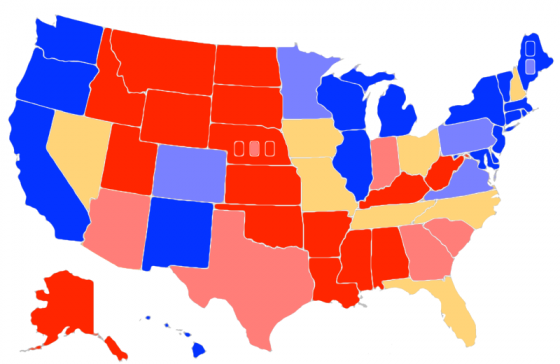
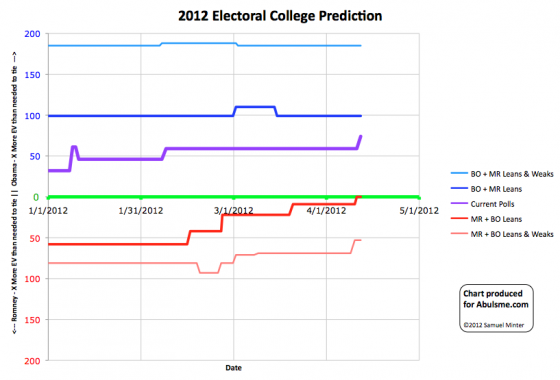
Map and chart from the Abulsme.com 2012 Electoral College Prediction page. Both assume Obama vs Romney with no third party strong enough to win states. Both show the polling situation as it currently exists. Things can and will change before election day. On the map Red is Romney, Blue is Obama, Gold States are too close to call. Lines on the chart represent how many more electoral votes a candidate would have than is needed to tie under several different scenarios. Up is good for Obama, Down is good for Romney.
The latest polls move my five poll average in North Carolina from barely Romney to barely Obama. The reality is that the margin is still essentially too close to call (Obama ahead by 0.2%). North Carolina is firmly a swing state at the moment. So this doesn’t change the range of possibilities between Obama getting all swing states and Romney getting all swing states… but it does move our “everybody gets the states they are ahead in” line further toward Obama. In this case, we have Obama now winning 343 to 195.
This is the third change in three days in Obama’s favor.
The summary:
|
Romney |
Obama |
| Romney Best Case |
269 |
269 |
| Current Status |
195 |
343 |
| Obama Best Case |
170 |
368 |
Edited 2012 Apr 12 21:24 UTC to replace an errant “McCain” with the intended “Romney”. Thanks JH for pointing out the error.
In the latest Curmudgeon’s Corner Sam talks about:
- Car GPSes
- Goodbye Santorum
- General Election 2012
- Interpreting Election Coverage
Just click to listen now:
[wpaudio url=”http://www.abulsme.com/CurmudgeonsCorner/cc20120410.mp3″ text=”Recorded 10 Apr 2012″]
or
 1-Click Subscribe in iTunes 1-Click Subscribe in iTunes
 View Podcast in iTunes View Podcast in iTunes
 View XML Feed View XML Feed
|
 |

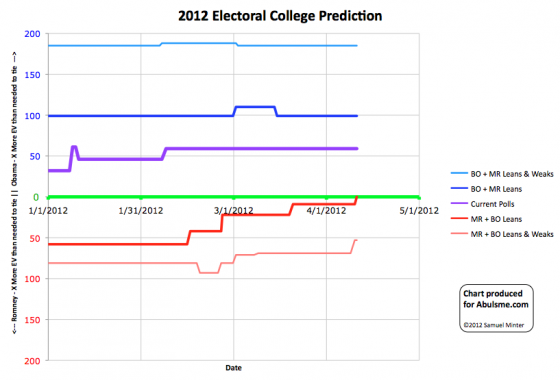
Map and chart from the Abulsme.com 2012 Electoral College Prediction page. Both assume Obama vs Romney with no third party strong enough to win states. Both show the polling situation as it currently exists. Things can and will change before election day. On the map Red is Romney, Blue is Obama, Gold States are too close to call. Lines on the chart represent how many more electoral votes a candidate would have than is needed to tie under several different scenarios. Up is good for Obama, Down is good for Romney.
Just yesterday I was mentioning that at some point things have to stop getting worse for Romney. Yesterday was not that day. Neither is today. Today my poll average for Colorado sees Obama’s lead increase to over 5%. So I color the state light blue and take it out of swing state status.
So, if we give Romney every single one of the remaining swing states… we end up with a 269 to 269 electoral vote tie. In all fairness, ties go to the House and almost certainly that would lead to a Romney win. So Romney can still pull out that very messy win.
But this means that with current polling Romney would not be able to manage a direct win in the electoral college, even in the most favorable disposition of the swing states. That is a remarkably bad position to be in, even this early.
The overall summary looks like this:
|
Romney |
Obama |
| Romney Best Case |
269 |
269 |
| Current Status |
210 |
328 |
| Obama Best Case |
170 |
368 |
Given that, lets compare to four years ago…
On April 11th 2008 if each candidate won every state where they were ahead, McCain would have beaten Obama 283 to 255. He would have won by 28 electoral votes. That is a tight victory in electoral college terms but it is a victory.
Meanwhile, today, if each candidate won every states where they are ahead, Obama would beat Romney 328 to 210. That is a 118 electoral vote margin.
Romney is in a much worse position now than McCain was in four years ago. Of course McCain ended up losing by a pretty substantial margin. So should we all just go home? Obama is going to win, so why bother even having a campaign? No. Not hardly. If we were seeing these numbers in October… then maybe, like I did on October 3rd 2008 when McCain’s best case got this bad, I’d say exactly that. But it is not October. It is April.
Despite McCain’s small lead at this time four years ago the actual election ended up being Obama 365 McCain 173… a 192 electoral vote margin for Obama. So big swings can happen. In 2008 between April 11th and election day 110 electoral votes moved in Obama’s direction. If Romney’s campaign manages to move a similar 110 electoral votes his way… he would win easily.
So even though Obama is way ahead based on today’s polling, the battle has just barely begun. There is a lot more to come.
As our recently departed Senator Santorum would say, “Game On!”
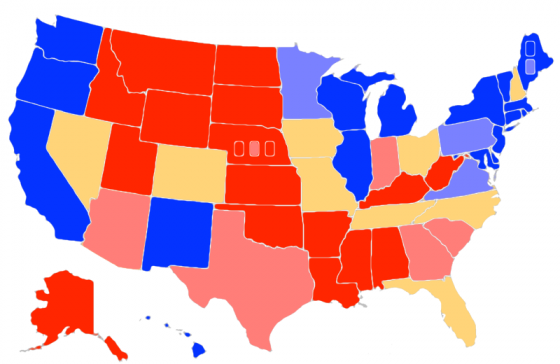
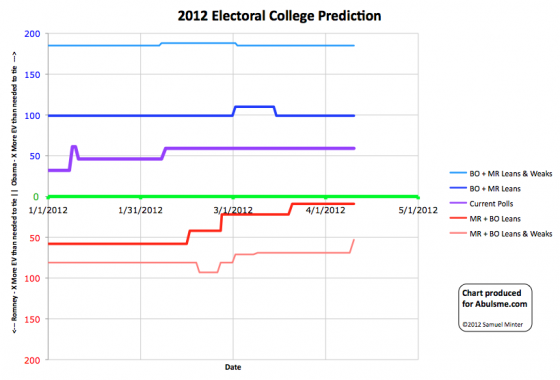
Map and chart from the Abulsme.com 2012 Electoral College Prediction page. Both assume Obama vs Romney with no third party strong enough to win states. On the Map Red is Romney, Blue is Obama, Gold States are too close to call. Lines on the chart represent how many more electoral votes a candidate has than is needed to tie under several different scenarios. Up is good for Obama, Down is good for Romney.
At some point things have to stop getting worse for Romney, right? As he pivots from the primaries to the general election, he’ll start pulling back support from the middle and start gaining ground again, right? Well, probably. But not yet. In today’s update the 5 poll average for Michigan moves to Obama having more than a 10% lead in that state. So we color the state dark blue. Essentially this means it is a state Romney probably shouldn’t bother putting any resources into at all. The situation may change later, but for the moment, it is out of reach.
Since Michigan isn’t moving in or out of Swing State status, the overall summary remains the same with Obama clearly the favorite by a large margin, but Romney still being able to squeak by with a win if he manages to sweep all of the too close to call swing states:
|
Romney |
Obama |
| Romney Best Case |
278 |
260 |
| Current Status |
210 |
328 |
| Obama Best Case |
170 |
368 |
One thing to keep in mind at this stage is that state polling is still sparse. So the “five poll averages” I use for this analysis can cover a lot of time. For instance, in Michigan my five poll average currently has polls that were done all the way back through January. (Specifically it includes one from January, two from February, one from March and one from April.)
There are still just a handful of state polls per week. Some states actually haven’t even been polled at all and I’m extrapolating based on the 2004 and 2008 elections. I’m also doing a straight average, not a recency weighted average. Because of this, this analysis will react more slowly to changes in the political situation.
At least that is the situation here in April. As we get closer and closer to November, we’ll have a faster and faster pace of polls. By the time we get to October we will have many new state polls every week, and changes in this analysis will be much more frequent and catch changes faster.
Edit 2012 May 30 15:49 UTC: It turns out that between the last update on Mar 30 and this one New Hampshire should have moved from Weak Romney to Lean Romney on Mar 31. At that time however, I was missing some polls and thought New Hampshire was already Lean Romney, so no update was posted. This is corrected in the historical charts starting on May 30.
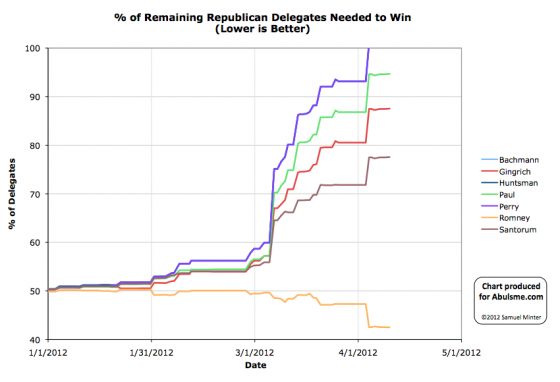
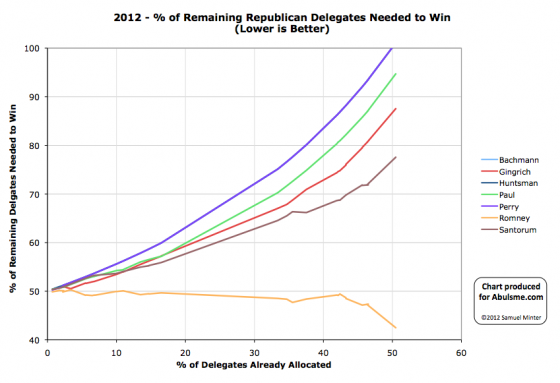
Charts from the Abulsme.com 2012 Republican Delegate Count Graphs page. When a candidate gets down to 0%, they have cinched the nomination. If they get up past 100%, they have been mathematically eliminated. The first chart is by date, the second is by “% of Delegates Already Allocated”. These numbers include estimates of the eventual results of multi-stage caucus processes which will be refined as the later stages occur.
You’d think the remaining superdelegates would be rushing in a mob to get on the Romney bandwagon at this point, but not so far. We have an additional super from Massachusetts today. Well, actually DCW identified the new super on Saturday, but it took Green Papers a few days to update their Massachusetts numbers. Since we go by Green Papers here, we waited. :-)
In any case, this is only one delegate, so only very minor changes to the “% of remaining needed to win” numbers:
- Romney: 42.54% -> 42.49%
- Santorum: 77.49% -> 77.56%
- Gingrich: 87.47% -> 87.54%
- Paul: 94.62% -> 94.70%
And now we continue to yawn and wait in the lull before the next actual contests. Not that there is much contest left anyway, but Romney still does need to mop up the rest of the 1144 delegates he needs.
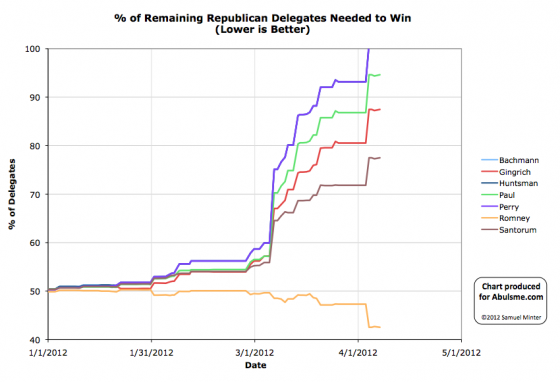
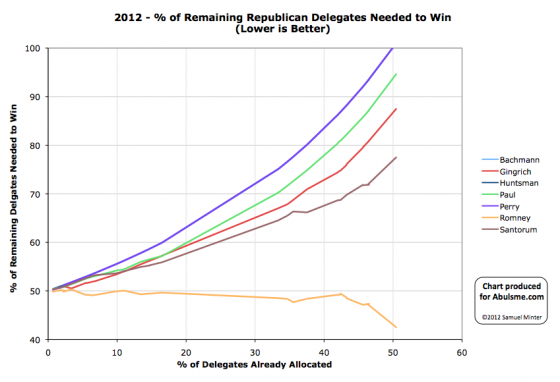
Charts from the Abulsme.com 2012 Republican Delegate Count Graphs page. When a candidate gets down to 0%, they have cinched the nomination. If they get up past 100%, they have been mathematically eliminated. The first chart is by date, the second is by “% of Delegates Already Allocated”. These numbers include estimates of the eventual results of multi-stage caucus processes which will be refined as the later stages occur.
So… remember yesterday when I removed three delegates from Romney’s column because Green Papers decided the three super delegates in Wisconsin were not bound by the primary results? Well, in today’s update they put them back. They are now officially “uncommitted” in their hard count, but are Romney in the soft count (which we use for these charts). The soft count indicates not just the official status, but other indicators of the ways the delegates are likely to vote.
In any case, this reverts things to how they were a couple days ago on our charts.
I’m sure Romney will breathe a lot easier with these three delegates back in his column. :-)
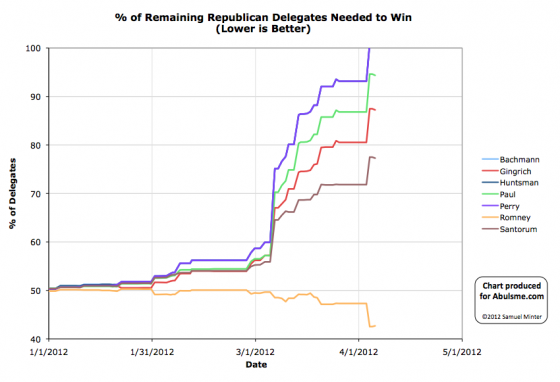
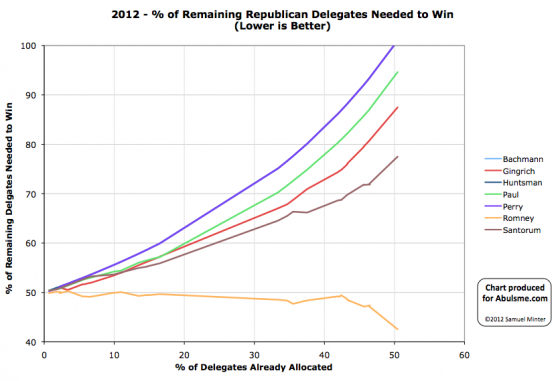
Charts from the Abulsme.com 2012 Republican Delegate Count Graphs page. When a candidate gets down to 0%, they have cinched the nomination. If they get up past 100%, they have been mathematically eliminated. The first chart is by date, the second is by “% of Delegates Already Allocated”. These numbers include estimates of the eventual results of multi-stage caucus processes which will be refined as the later stages occur.
So, Green Papers updated their Wisconsin numbers. They had been 33 Romney, 9 Santorum. They are now 30 Romney, 9 Santorum, 3 still available. Green Papers’ latest update commentary indicates that they had previously thought these superdelegates were bound by the primary results, but it turns out they are not. DCW still says however that those superdelegates are bound by the election results and don’t have independent free choice here, in which case they probably really should be in the Romney column. In fact DCW only made that change on the 4th. So I’m not really sure who is right here.
For purposes of our counts, we go with Green Papers though, so Romney loses the three delegates from his count. If information is found that these superdelegates are bound after all, Green Papers will update accordingly.
The changes to the “% of remaining delegates needed to win” number:
- Romney: 42.5% -> 42.7%
- Santorum: 77.5% -> 77.3%
- Gingrich: 87.5% -> 87.2%
- Paul: 94.6% -> 94.4%
So bad for Romney (since he loses 3 delegates for now) and good for everybody else since these delegates are theoretically now up for grabs again.
But really, this changes nothing.
Romney is the nominee.
Edit 2012 Apr 6 07:07 UTC to refer to both GP and DCW’s views on the 3 superdelegates being bound after I found GP’s comments on this.
|
|

















